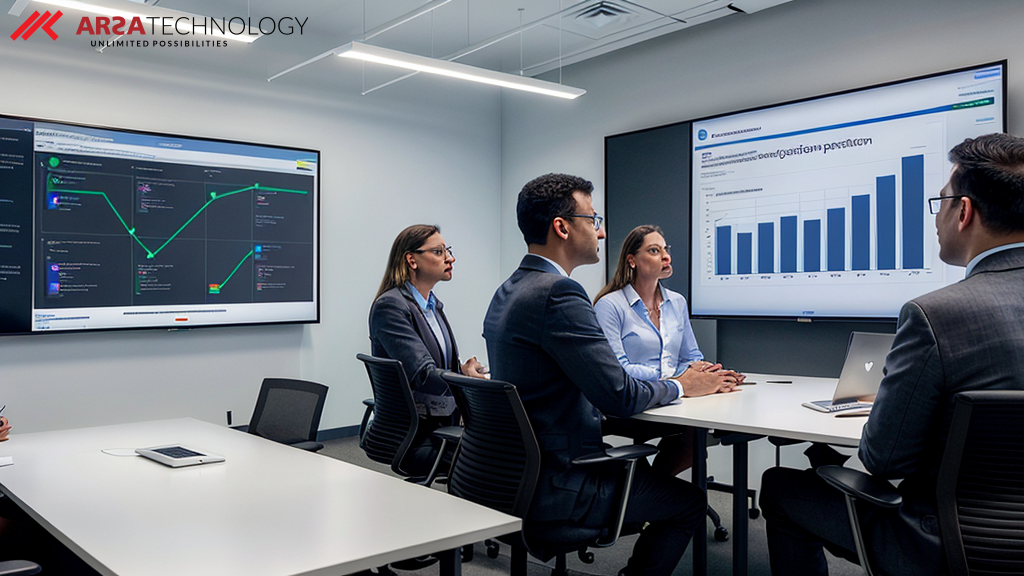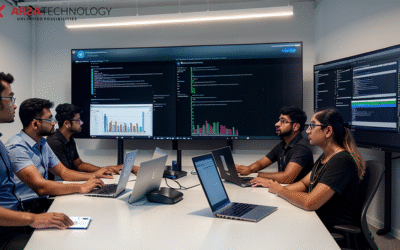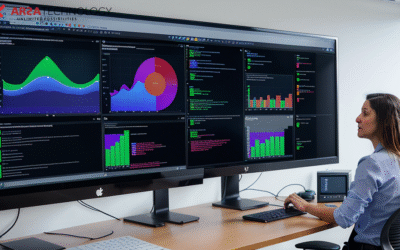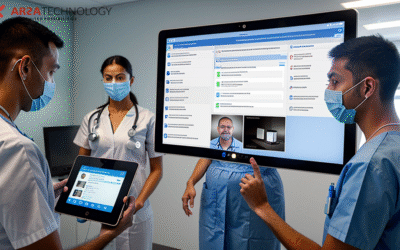Introduction: Overcoming Slow Digitization of Citizen Services in the Government Sector
Government agencies worldwide face the persistent challenge of slow digitization. Legacy systems, complex bureaucratic processes, and an inherent resistance to change often hinder the swift adoption of modern technologies that could dramatically improve efficiency, security, and citizen engagement. This is particularly evident in critical areas like employee attendance automation, where outdated methods can lead to inefficiencies, potential inaccuracies, and a drain on resources. The aspiration to deliver more responsive and secure citizen services often clashes with the reality of operational bottlenecks.
ARSA Technology understands these challenges. We recognize that for government entities, the move towards a more digital future isn’t just about adopting new tools; it’s about transforming the very fabric of public service delivery. Our high-performance Face Recognition API offers a robust solution designed to accelerate this transformation, providing a pathway to streamline operations, enhance security, and lay the groundwork for a truly modern digital government. This guide is crafted for software developers, solutions architects, CTOs, and product managers within government, outlining a strategic approach to migrating from existing, less efficient systems to ARSA’s advanced biometric capabilities.
The Imperative for Change: Why Legacy Systems Fall Short
Many government departments still rely on manual or semi-automated processes for employee attendance, facility access, and identity verification. These systems, while familiar, are often fraught with limitations:
* Manual Overhead: Time-consuming data entry, reconciliation, and reporting divert valuable personnel from more critical tasks.
* Security Vulnerabilities: Traditional methods like swipe cards or PINs are susceptible to loss, theft, or unauthorized sharing, posing significant security risks.
* Accuracy Issues: Human error in manual recording or limitations of older biometric technologies can lead to inaccuracies in attendance records, impacting payroll and resource planning.
* Scalability Challenges: As government agencies grow or expand services, legacy systems struggle to scale efficiently, leading to performance degradation and increased operational costs.
* Lack of Integration: Older systems often operate in silos, making it difficult to integrate with modern HR, payroll, or security platforms, thereby hindering a holistic digital strategy.
These shortcomings directly contribute to the “slow digitization of citizen services” by consuming resources that could otherwise be allocated to innovation and service improvement. A modern, reliable secure identity verification solutions is not merely a technological upgrade; it’s a strategic investment in the future of public administration.
Introducing ARSA Technology’s Face Recognition API: A Catalyst for Government Modernization
ARSA Technology’s Face Recognition API is engineered for precision, speed, and reliability, making it an ideal choice for the demanding requirements of government applications. It provides a sophisticated yet accessible way to integrate advanced facial recognition capabilities into existing or new systems. Our API is built to handle high volumes of requests with exceptional accuracy, ensuring seamless operation even in large-scale deployments typical of government organizations.
The core strength of ARSA’s API lies in its ability to accurately identify individuals, verify identities against a database, and detect faces in various scenarios. This capability is foundational for transforming processes like employee attendance, where a quick, secure, and touchless verification method can revolutionize daily operations. To see the API in action, try the Face Recognition API on RapidAPI. This interactive demo allows you to explore its functionality and understand its potential without requiring any complex setup.
Strategic Advantages of Migrating to ARSA’s Face Recognition API
Migrating to ARSA Technology’s Face Recognition API offers a multitude of strategic benefits for government agencies:
Enhancing Operational Efficiency and Resource Allocation
By automating employee attendance with facial recognition, government departments can eliminate manual timekeeping, reduce administrative burden, and free up staff to focus on higher-value tasks. This directly contributes to a more efficient allocation of public resources. The speed of biometric verification means less queuing and faster processing, improving the daily experience for employees.
Fortifying Security and Preventing Fraud
Security is paramount in government. Our Face Recognition API provides a robust layer of security for identity verification, ensuring that only authorized personnel gain access to facilities or systems. For attendance, it effectively prevents “buddy punching” or proxy attendance, a common form of fraud in traditional systems. Furthermore, integrating with our preventing fraud with liveness detection API adds another critical layer, ensuring that the person presenting their face is a real, live individual and not a spoof attempt using photos or videos. This combination creates an exceptionally secure environment.
Ensuring Accuracy and Data Integrity
ARSA’s advanced algorithms deliver high accuracy in facial recognition, minimizing errors in identification and verification. This translates into reliable attendance records, precise payroll processing, and enhanced data integrity across all applications where the API is deployed. Accurate data is crucial for informed decision-making and transparent public administration.
Scalability and Future-Proofing Digital Initiatives
Designed for enterprise-level performance, ARSA’s API scales effortlessly to meet the demands of government agencies of all sizes, from small departments to large national organizations. This scalability ensures that your investment today will continue to serve your needs as your digital transformation journey evolves, supporting a growing number of users and services without compromising performance.
Improved User Experience for Employees and Citizens
A touchless, seamless facial recognition system offers a superior user experience. For employees, it means faster clock-ins and clock-outs. For future citizen services, it can enable quick and secure access to digital platforms, reducing friction and improving satisfaction. This modernization reflects a commitment to leveraging technology for the benefit of all stakeholders.
A Phased Approach to Migration: Best Practices for Government Agencies
Migrating an existing system to a new API requires careful planning and execution. Here’s a conceptual guide to a successful transition:
1. Comprehensive Assessment and Planning
Begin by thoroughly evaluating your current attendance or identity verification system. Document existing workflows, identify integration points, and define clear objectives for the migration. What specific pain points do you aim to solve? What are the key performance indicators (KPIs) for success? This phase should involve all relevant stakeholders, including IT, HR, security, and procurement. Outline a phased rollout strategy, perhaps starting with a pilot department or a specific facility.
2. Solution Design and Integration Strategy
Once objectives are clear, design how ARSA’s Face Recognition API will integrate into your existing infrastructure. This involves conceptualizing how data will flow between your systems and the API. Consider how existing user databases will be migrated or synchronized. For instance, employee photos can be enrolled into ARSA’s system, linked to existing employee IDs. The focus here is on the architectural overview and data mapping, not on writing code.
3. Pilot Implementation and Testing
Before a full rollout, implement the ARSA Face Recognition API in a controlled pilot environment. This allows your team to test the integration, validate performance, and gather feedback from a smaller group of users. Rigorous testing should cover various scenarios, ensuring accuracy, speed, and reliability. This phase is crucial for identifying and addressing any unforeseen challenges in a low-risk setting.
4. Data Migration and Enrollment
Prepare your existing employee data for migration. This typically involves extracting relevant information and securely enrolling employee facial biometrics into the ARSA system. Ensure data privacy and compliance with government regulations are strictly adhered to throughout this process. ARSA Technology prioritizes secure data handling, and your integration should reflect this commitment.
5. Full Deployment and Monitoring
After successful pilot testing, proceed with a phased or full deployment across your agency. Provide adequate training and support for users and administrators. Post-deployment, continuous monitoring of the system’s performance, accuracy, and security is essential. Establish clear feedback channels to address any issues promptly and optimize the system over time.
Realizing the Vision: Employee Attendance Automation with ARSA
Consider the impact on employee attendance automation. Instead of manual sign-in sheets or error-prone card readers, employees simply present their face to a camera. The ARSA Face Recognition API instantly verifies their identity, marking their attendance with high precision. This not only saves time but also provides an indisputable record, enhancing accountability and transparency.
The integration of preventing fraud with liveness detection ensures that the system is not fooled by static images or videos, providing an additional layer of security critical for government operations. This robust, automated system allows HR departments to focus on strategic initiatives rather than administrative tasks, contributing directly to the overall efficiency of public service delivery.
Beyond Attendance: Broader Applications for Government Digitization
While employee attendance automation is a powerful starting point, the capabilities of ARSA’s Face Recognition API extend far beyond. Government agencies can leverage this technology for:
* Secure Facility Access: Granting authorized personnel secure and seamless entry to government buildings and restricted areas.
* Citizen Identity Verification: Future-proofing online citizen services by providing a secure, convenient method for identity verification for applications, permits, or access to sensitive information, aligning with the goal of secure identity verification solutions.
* Visitor Management: Streamlining visitor registration and ensuring secure entry protocols for public buildings.
By adopting ARSA’s API, government agencies are not just solving a single pain point; they are investing in a versatile technology that can serve as a cornerstone for broader digital transformation efforts, ultimately accelerating the digitization of citizen services.
Conclusion: Your Next Step Towards a Solution
The journey towards a fully digitized government, characterized by efficient operations, enhanced security, and superior citizen services, requires robust, reliable, and scalable technology partners. ARSA Technology’s Face Recognition API is specifically designed to meet these stringent demands, offering a proven path to overcome the challenges of slow digitization. By migrating to our advanced biometric solutions, government agencies can unlock significant operational efficiencies, bolster security postures, and lay the foundation for a more modern, responsive public administration. This is not just a technological upgrade; it is a strategic imperative for the future of public service.
Ready to Solve Your Challenges with AI?
Discover how ARSA Technology can help you overcome your toughest business challenges. Get in touch with our team for a personalized demo and a free API trial.







